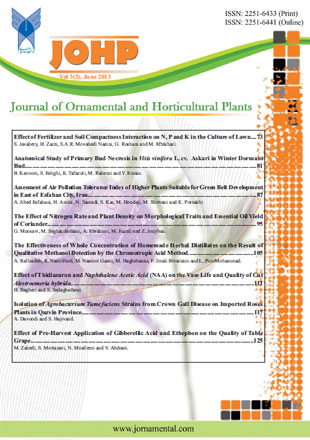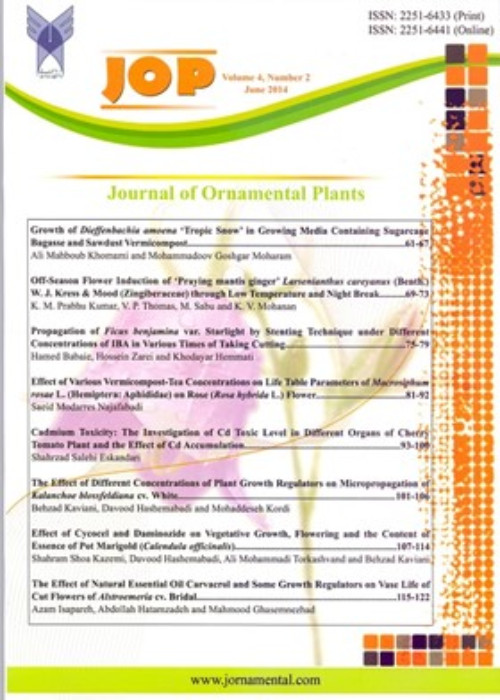فهرست مطالب

Journal of Ornamental Plants
Volume:3 Issue: 2, Spring 2013
- تاریخ انتشار: 1392/05/06
- تعداد عناوین: 8
-
Page 73Under favorable soil conditions such as existence of easily destructible organic compounds, balanced heat and moisture, adequate ventilation and abundant nutrients, organic materials are mineralized. Once mineralizing occurs, mineral elements like P, S, Ca, Mg, K and other cations are released. A related study was conducted to determine the effect of seven organic fertilizers (Leaf Mold (LM), Rice Husk (RH), manure, Spent Mushroom Compost (SMC), mixture of LM, RH and SMC (M1), mixture of LM, RH and manure (M2) with the ratio of 1:1:1 and control) at three levels of soil compactness (roller weight of 36, 56 and 76 kg) on N, P, K content of soil and aril parts of sport lawn. Treatments were applied as strip plot design in three replications, in research farm of Gorgan University of Agricultural Sciences and Natural Resources during 2008-2009. According to the results of this study, in all three compactness levels, treatments containing manure and SMC showed more N and K in contrast to control treatment. The most content of soil P in each compactness level was observed in plots fertilized with manure. The manure and control treatments showed the most and the least amount of plant nitrogen in all compactness treatments respectively. The manure and SMC treatments and also treatments containing these organic matters increased plant phosphorus content in compare with RH, LM and control treatments. Also in three compactness, manure and SMC treatments showed more plant potassium in contrast to control.Keywords: Culture bed, Mineralization, Sport lawn
-
Page 81Primary bud necrosis in grapevine is a physiological disorder observed in the compound buds. This study was conducted to investigate the anatomical changes in cv. Askari grapevine in winter dormant buds. Bud samples were taken from Askari grapevine at Sisakht vineyards, south-western of Iran. Compound buds were dissected and assessed under a binocular microscope at 10-40x magnification and a digital microscope (Dinolite-AM413T) was used for taking photos. The results showed that the bud necrosis incidence was observed in primary buds more than in the secondary buds. Anatomical observations showed that PBN disorder occurred in central buds as brown small spot and gradually developed in the whole bud and bud necrotic remained on canes and did not abscission. On the results of present study, dissecting buds in autumn can raise awareness of PBN and fruitfulness of bud in the following spring, hence, growers should determine the level of bud necrosis prior to winter pruning so that pruning techniques might be adjusted to account for the bud damage.Keywords: Askari grape, PBN, Disorder, Primary, Secodary bud
-
Page 87Development of a green belt with suitable plant species around the source of emission can mitigate the atmospheric contamination. Selection of such plant species are required to combat air pollution based on their tolerance level. Present study was undertaken to evaluate the tolerance level of higher plants in East of Esfahan city, Iran, during 2011 in terms of assessing Air Pollution Tolerance Index (APTI). Leaf extract of nine plant species showed elevated levels of pH, ascorbic acid, chlorophyll and relative water content. Stress metabolites like ascorbic acid and chlorophyll of certain plant species exhibits different levels of sensitivity and tolerance towards air pollution. Dust deposition on leaf surfaces was estimated to observe the extent of particulate deposition. The highest and the lowest deposition rates were observed in Morus alba and Cercis siliquastrum, respectively. Among the nine different plant species examined, APTI value is maximum in Morus alba suggesting its higher tolerance.Keywords: Air pollution, Air pollution tolerance index (APTI), Esfahan city, Higher plants
-
Page 95In order to study the effect of nitrogen rate and plant density on morphological traits and essential oil and fruit yield of coriander, a split-plot experiment was carried out in research field of Islamic Azad University, Birjand Branch, Birjand, Iran in 2010 based on a randomized complete block design with three replications.The main plots were nitrogen rates at four levels (0, 40, 80 and 120 kg N/ha) and the sub-plots were plant densities at three levels (30, 40 and 50 plants/m2). The results showed that nitrogen rate had significant effect on fruit yield, essential oil percent and yield traits and interaction between nitrogen rate and plant density only affected fruit yield but change in plant density significantly affected all traits except essential oil percent. Means comparison showed that as N fertilization rate was increased from 0 to 80 kg N ha-1, plant height and fruit yield were increased by 19.8 and 74.1 %, respectively. Also, essential oil percent increased from 0.153 to 0.33% and essential oil yield was greater 2.68 times. Moreover, means comparison showed that the increase in plant density from 30 to 50 plants/m2, increased plant height, first fruit distance from ground, fruit and essential oil yield by 14.3, 27.6, 31.3 and 36.8%, respectively while stem diameter and branch number per main stem were decreased by 22.2 and 13.9%, respectively. Given the results of the study, the treatment of 80 kg N/ha application with the density of 50 plants/m2 recommended for the cultivation of coriander in Birjand, Iran.Keywords: Coriander, Nitrogen rate, Plant density, Morphological traits, Essential oil, Fruit yield
-
Page 105occurrence of blindness after drinking some herbaceous distillates is created some anxieties in Iran. In this study, the effectiveness of concentration of Khalvash distillate was studied on the function of the new modified suggested chromotropic acid method for qualitative detection of methanol.
For this purpose, three samples of Khalvash distillate were purchased from vendors of Rasht. According to the obtained results, due to special chemicals and their high concentrations in the studied homemade samples, using of 1:5 dilution ratio in the distillate water is necessary for test performance. Also, it was confirmed that methanol was present in all Khalvash samples like other herbal ones.Keywords: Chromotropic acid, Herbaceous distillates, Methanol, Qualitative detection -
Page 111Alstromeria is a new cut flower in Iran that due to the high performance, long life, and pretty flowers and colors diversity is highly regarded. Premature yellowing of leaves in cut flowers Alstromeria before petal fall is the most important factor limiting the vase life of flowers. To delay leaf yellowing and increased quality, factorial experiment based on completely randomized design carried out with the two factors thidiazuron (TDZ) (0, 10, 20 and 50 mg l-1) and naphthalene acetic acid (NAA) (0, 10 and 20 mg l-1). Results showed that the maximum vase life and the value of chlorophyll b were achieved (20 mg l-1 thidiazuron 20 mg l-1 NAA) and the most petals proteins was related to treatment 10 mg l-1 thidiazuron and 20 mg l-1 NAA. The most petals carotenoids and dry matter content and the least ethylene production was obtained in 10 mg l-1 TDZ and 10 mg l-1 NAA, respectively.Keywords: Alstromeria, Carotenoids, Naphthalene Acetic Acid, Thidiazuron, Vase life
-
Page 117Cultivar of roses (Rosa spp.) has been grown in greenhouses in Qazvin region of Iran for local markets. Agrobacterium tumefaciens strains were isolated and identified from six different samples of roses plants imported from the Netherland to Iran. During August and September of 2012, nearly 2- 5% of rose plants in two different greenhouses in the province of Qazvin were observed with crown gall symptoms on various parts, particularly in the stem.
A non-fluorescent gram-negative bacterium was consistently isolated from diseased tissues on to King's B medium. The isolated strains were confirmed as Agrobacterium using different biochemical and pathogenicity (tumor forming ability) tests. Four representative strains isolated were aerobic, non-sporing, non-pigmented, motile, rod-shaped, oxidase negative and catalase positive. All of four isolates were positive for tumor forming ability in pathogenicity tests on carrot disc and tomato stem.Keywords: Rose cultivars, Agrobacterium tumefaciens, Crown gall, Qazvin -
Page 125this study the effects of plant growth regulators including; GA3 (0 and 50 mg/l) and ethephon (0 and 500 mg/l) were studied on the quality properties of two grape cultivars (Perlette and Yaghuti). At the harvest time, some physicochemical characteristics such as fruit cluster weight, fruit diameter, length, volume and L/D ratio, flesh firmness, fresh weight, TA, pH, TSS and fruit color were measured at the harvest time. Results showed that fruits treats with GA3 had the highest, cluster weight, fruit diameter, length, volume and L/D ratio compared to ethephon, although pH and flesh firmness showed no differences between the treatments. None of treatments affected negatively the quality of the fruit in term of TSS. Using of GA3 Ethephon treatment significantly increased cluster weight, length, volume, L/D ratio and fresh weight in both cultivars. Ethephon had no significant effect on the fruit size, but promoted berry softening and its effect was different for studied quality parameters.Keywords: Plant growth regulators (PGRs), Titratable acidity (TA), Total soluble solids (TSS)


